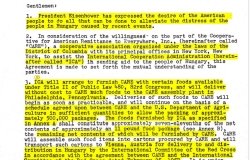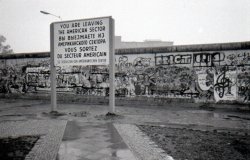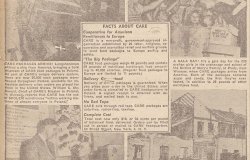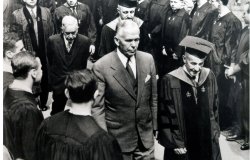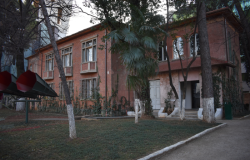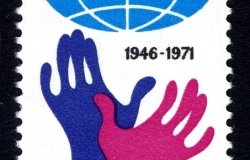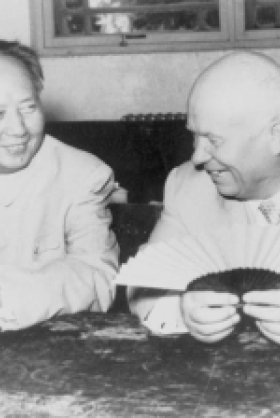Continental Defense in the Eisenhower Era: Nuclear Antiaircraft Arms and the Cold War
Christopher Bright, Author, Continental Defense in the Eisenhower Era, Robert S. Norris, Natural Resources Defense Council
Overview
 Fueled by Cold War anxiety about the threat of a surprise nuclear attack by Soviet jet-bombers, the U.S. nuclear arsenal ballooned from 841 warheads when President Eisenhower assumed office in 1953 to over 18,000 by the time he left office in 1961. Roughly 20% of these warheads were based around cities and military installations throughout the U.S. for air defense purposes. The fact that the widely publicized deployment of over 3,500 nuclear weapons explicitly intended for use directly over or near U.S. territory enjoyed broad public support is a telling measure of early Cold War fears, according to Christopher Bright, author of Continental Defense in the Eisenhower Era: Nuclear Antiaircraft Arms and the Cold War.
Fueled by Cold War anxiety about the threat of a surprise nuclear attack by Soviet jet-bombers, the U.S. nuclear arsenal ballooned from 841 warheads when President Eisenhower assumed office in 1953 to over 18,000 by the time he left office in 1961. Roughly 20% of these warheads were based around cities and military installations throughout the U.S. for air defense purposes. The fact that the widely publicized deployment of over 3,500 nuclear weapons explicitly intended for use directly over or near U.S. territory enjoyed broad public support is a telling measure of early Cold War fears, according to Christopher Bright, author of Continental Defense in the Eisenhower Era: Nuclear Antiaircraft Arms and the Cold War.
Delving into the nature of the perceived threat, Bright explained that because of advances in bomber technology which allowed them to fly higher and faster than ever before, the main air defense systems of the early 1950s—anti-aircraft artillery and fighter interceptors—were not judged capable of effectively defending against a large Soviet attack. Even destroying the aircraft, Bright pointed out, could not guarantee that its nuclear payload would not detonate upon impact.
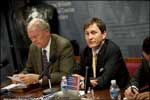 Significant support for the development and deployment of nuclear anti-aircraft arms came from Robert Sprague, a New England industrialist, top Eisenhower advisor on air defense issues, and key contributor to the 1955 Killian Commission Report on U.S. military capabilities. Best known for endorsing the development of the U-2 spy plane, the Killian Report also made three recommendations on air defense issues—all of which were later adopted. The report recommended the continued development of nuclear anti-aircraft weapons, that launch authority be ‘pre-delegated' to air defense installation commanders who would be empowered to use nuclear weapons on their own authority in the face of ‘unambiguous' evidence of Soviet attack, and finally that the public be educated about the necessity, safety and merit of these activities.
Significant support for the development and deployment of nuclear anti-aircraft arms came from Robert Sprague, a New England industrialist, top Eisenhower advisor on air defense issues, and key contributor to the 1955 Killian Commission Report on U.S. military capabilities. Best known for endorsing the development of the U-2 spy plane, the Killian Report also made three recommendations on air defense issues—all of which were later adopted. The report recommended the continued development of nuclear anti-aircraft weapons, that launch authority be ‘pre-delegated' to air defense installation commanders who would be empowered to use nuclear weapons on their own authority in the face of ‘unambiguous' evidence of Soviet attack, and finally that the public be educated about the necessity, safety and merit of these activities.
Drawing extensively upon local media coverage throughout the U.S., especially of ground-based Nike-Hercules missile deployments, as well as official Department of Defense (DoD) statements and press releases, Bright explained that DoD publicity efforts contributed to overall public support for nuclear anti-aircraft missiles in the 1950s.  One effort to demonstrate the safety of nuclear anti-aircraft weapons involved having five Air Force officers stand in their typical summer uniforms directly beneath an exploding Genie air-to-air rocket. Photographs of the men during the explosion and subsequent interviews indicating that they had been unable to detect significant fallout in the area following the explosion were widely disseminated to the media as evidence that nuclear anti-aircraft missiles posed no threat to the American public.
One effort to demonstrate the safety of nuclear anti-aircraft weapons involved having five Air Force officers stand in their typical summer uniforms directly beneath an exploding Genie air-to-air rocket. Photographs of the men during the explosion and subsequent interviews indicating that they had been unable to detect significant fallout in the area following the explosion were widely disseminated to the media as evidence that nuclear anti-aircraft missiles posed no threat to the American public.
Perhaps partially in response to the threat to Soviet bombers that these weapons posed, the USSR directed its efforts towards the development of Intercontinental Ballistic Missiles (ICBMs) which could penetrate American defenses. Despite these Soviet advances, Bright pointed out, nuclear anti-aircraft weapons remained part of the U.S. inventory for thirty years. Not until the Genie rocket was retired in 1986 did the era of U.S. nuclear air defense draw to a close.
Expanding upon Bright's description of early Cold War anxiety, Robert S. Norris, senior research associate with the National Resources Defense Council's Nuclear Program, explained that atomic spy scandals like those involving Klaus Fuchs and the Rosenbergs, the Soviet Union's August 1953 test of a hydrogen bomb and especially fears of ‘an atomic Pearl Harbor' created a political climate in which deployment of new defensive capabilities was welcome. Norris went on to point out that this climate was fueled by DoD public relations initiatives, as well as the public's love affair with nuclear weapons.
Looking back upon the intra-government dialogue surrounding the growth of the U.S. nuclear arsenal and its continental defense mission, Norris pointed out that in addition to inter-service rivalry and competition between Lawrence Livermore and Los Alamos National Labs, sheer chance played an important role in the growth of the nuclear arsenal. Different circumstances and bureaucratic processes could have resulted in smaller or larger arsenals in vastly different configurations. Commenting upon the arsenal's exponential growth generally as well as the fact that so many warheads were intended to be used over or near the United States, Norris quipped "Well, it seemed like a good idea at the time…"
_____________
The National Security Archive prepared an electronic briefing book using key documents from Christopher Bright's research--available online at the the National Security Archive website.
For more information on Continental Defense in the Eisenhower Era: Nuclear Antiaircraft Arms and the Cold War and author Christopher Bright, visit www.ChristopherJohnBright.com
Documents & Downloads
Hosted By

Nuclear Proliferation International History Project
The Nuclear Proliferation International History Project is a global network of individuals and institutions engaged in the study of international nuclear history through archival documents, oral history interviews, and other empirical sources. At the Wilson Center, it is part of the Wilson Center's History and Public Policy Program. Read more

Nuclear Proliferation International History Project
The Nuclear Proliferation International History Project is a global network of individuals and institutions engaged in the study of international nuclear history through archival documents, oral history interviews, and other empirical sources. At the Wilson Center, it is part of the Wilson Center's History and Public Policy Program. Read more

History and Public Policy Program
The History and Public Policy Program makes public the primary source record of 20th and 21st century international history from repositories around the world, facilitates scholarship based on those records, and uses these materials to provide context for classroom, public, and policy debates on global affairs. Read more
Thank you for your interest in this event. Please send any feedback or questions to our Events staff.
